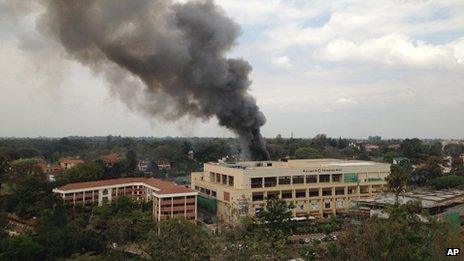KenyaÔÇÖs Westgate attack: How does al-Shabab work?
- Published

Smoke rises from the Westgate shopping centre in Nairobi.
In the aftermath of the deadly events at Nairobi's Westgate Mall, Kenya's security services will be expected to conduct a thorough post-mortem examination and implement strategies to prevent future attacks.
The scale, speed, ferocity and apparent sophistication of the Westgate assault have stunned many in Kenya's establishment. Such has been the magnitude and depth of consternation that a return to business-as-usual will, for many, be unacceptable.
The crisis has evidently tipped the scales but whether it can unleash the positive energy needed to radically reconfigure and transform the security architecture and culture is hard to tell.
Authorities have promised a speedy and forensic probe, but it may take time to produce a coherent narrative to explain who the masterminds were and how the operation was conceived.
Power struggles
But anecdotal evidence and fragments of intelligence have already emerged which offer potentially useful leads.
A number of sources, including the Kenyan government, now believe the attack was carried by a "multinational" team of between 10 and 15 militants.
Initial eyewitness accounts indicated women were involved but these have been dismissed or explained by the fact that some were disguised in women's clothing.
The claims about women for a while fed speculation that al-Shabab - the Somalia-based militant group that claimed responsibility for the operation - may not have been involved because it did not match the group's modus operandi.
The group has used female suicide bombers in the past but there is no evidence it has deployed women in active combat duties. Indeed, an al-Shabab spokesman dismissed the claim of female involvement.
The big question, however, remains whether al-Shabab has the capacity to conduct such a sophisticated operation beyond Somalia's borders at a time when it is weakened by factionalism and power struggles.
No less important a question is what tactical and strategic aims the operation was designed to advance?
The skill and capacity is certainly there, shown by the number of sophisticated large-scale bomb attacks and commando-style raids on government facilities in Mogadishu in recent months.
Assuming there is still a level of close coordination and skills transfer between the autonomous cells of al-Shabab, there is no reason why its cells in Kenya and the rest of East Africa cannot adopt the same tactics we have seen put to devastating effect in Mogadishu.
It is reasonable to assume the objective of the attack is propaganda - to spread the message that hardline factions allied to al-Shabab leader Ahmed Abdi Godane are still strong, cohesive and capable of striking their domestic and external enemies.
Mutant splinter faction?
Hardliners have been claiming that al-Shabab is more cohesive and potent after being purged of "hypocrites" and "ditherers".
In recent years it has shed senior figures like faction leader Hasan Dahir Aweys and former spokesman Mukhtar Robow. Others key figures like Ibrahim Al-Afghani and Omar Hammami (al-Amriki) have been assassinated.
So what better way to prove this new cohesion than to escalate the jihad with a spectacular operation?
This hypothesis assumes the hardliners are no longer guided by self-preservation and are oblivious or indifferent to the risks of provoking Kenya into a retaliation that would degrade their capabilities further.
A series of media interviews given on Monday by a man identifying himself as Abu Umar, an al-Shabab commander in the Somali port of Kismayo, has fed speculation that he might be speaking on behalf of a mutant new splinter faction.
Abu Umar spoke in impeccable English and offered details on the identity of the gunmen and the siege that suggested a command centre inside Somalia was in constant contact with the gunmen and running the operation.
Analysts have been excitedly speculating that the Westgate Mall attack was the work of a multinational jihadi outfit composed of Somali and foreign fighters eager to use the al-Shabab brand name, nominally sympathetic to its goals, but operationally autonomous of it.
It is a fantastical and disconcerting prospect that, given the context and complex evolution of violent extremism in Somalia, is impossible to discount.
- Published23 September 2013
- Published23 September 2013
- Published23 September 2013